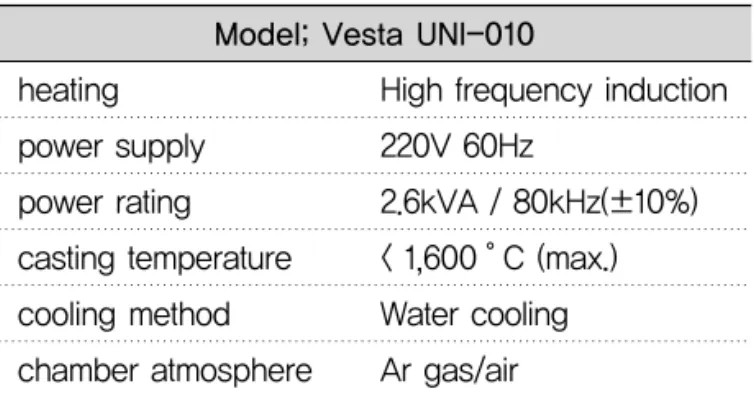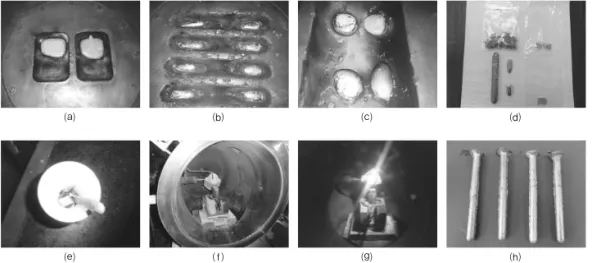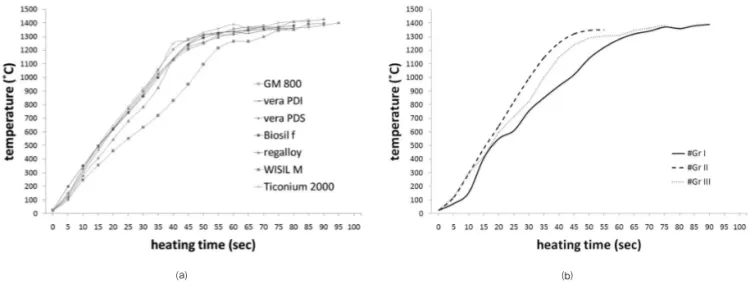Sn 및 Cu를 첨가한 치과 주조용
Co-Cr-Mo계 합금제조 및 용해과정 분석
강 후 원, 박 영 식*, 황 인**, 이 창 호**, 허 용**, 원 용 관***
동아인재대학교 치기공과, 한국광기술원*, (주)유니크**, 전남대학교 전자컴퓨터공학부***
Manufactures of dental casting Co-Cr-Mo based alloys in adddition to Sn, Cu and analysis of infrared thermal image for melting process of its alloys
Hoo-Won Kang, Young-Sik Park*, In Hwang**, Chang-Ho Lee**, Yong Heo**, Yong-Gwan Won**
Dept. of Dental Lab. Technology, Dong-A In-Jae College, Jeonnam 526-705, Korea 3D Convergence Research Center, KOPTI, Gwangju 500-779, Korea*
UNIQUE CO. LTD,, #201, BI Chosun University, 1110-10, Gwangju, Korea**
Dept. of Electronic & Commputer Eng., Chonnam National University, Gwangju 500-757, Korea***
Purpose: Dental casting #GrⅠ(Co-25Cr-5Mo-3Sn-1Mn-1Si), #GrⅡ(Co-25Cr-5Mo-5Cu-1Mn -1Si) and #GrⅢ
(Co-25Cr-5Mo-3Sn-5Cu-1Mn-1Si) master alloys of granule type were manufactured the same as manufacturing processes for dental casting Ni-Cr and Co-Cr-Mo based alloys of ingot type. These alloys were analyzed melting processes with heating time of high frequency induction centrifugal casting machine using infrared thermal image analyzer.
Methods: These alloys were manufactured such as; alloy design, the first master alloy manufatured using vacuum
arc casting machine, melting metal setting in crucible, melting in VIM, pouring in the mold of bar type, cutting the gate and runner bar and polishing. These alloys were put about 30g/charge in the ceramic crucible of high frequency induction centrifugal casting machine and heat, Infrared thermal image analyzer indicated alloys in the crucible were set and operated.
Results: The melting temperatures of these alloys measuring infrared thermal image analyzer were decreased in
comparison with remanium
ⓇGM 800+, vera PDI
TM, Biosil
Ⓡf, WISIL
ⓇM typeⅤ, Ticonium 2000 alloys of ingot type and vera PDS
TM(Aabadent, USA), Regalloy alloys of shot type.
Conclusion: Co-Cr-Mo based alloy in addition to Sn(#GrⅠ alloy) were decreased the melting temperature with
heating time of high frequency induction centrifugal casting machine using infrared thermal image analyzer.
[Abstract]
성 명 강 후 원 전 화 010-5672-7324 E-mail kanghw0106@hanmail.net 교신저자
본 논문은 2013년도 미래창조과학부 산학연협력 클러스터 핵심융합기술개발 지원사업에 의해서 이루어진 논문임.
Key words :Co-Cr-Mo-Sn-Mn-Si alloy, Co-Cr-Mo-Cu-Mn-Si alloy, Co-Cr-Mo-Sn-Cu-Mn-Si alloy, melting process, granule type, infrared thermal image analyzer, high frequency induction centrifugal casting machine
Ⅰ. 서 론
Co-Cr-Mo계 합금은 부식저항성이 크며, 생체친화성 이 우수하여 치과보철물로 국소의치 금속구조물, 총의치 상악구조물 및 금속도재관용 금속 하부구조물 제작으로 가장 많이 사용하고 있다. 또한 정형외과분야에서는 인체 의 경조직 대체 주입물(hard tissue replacement implants) 및 치과용 임플란트(dental implant) 등의 생 체재료에 적용하고 있다.
더불어 국소의치용 금속구조물로 사용되고 있는 치과 주조용 비귀금속 Co-Cr-Mo계 합금의 수요가 날로 증가 할 것으로 판단된다. 이러한 이유는 노령화 인구 증가와 2012년도 7월부터 이미 노인틀니의 의료 보험은 적용되 고 있고 2013년도 7월부터는 부분틀니인 국소의치도 의 료보험이 적용되기 시작하여, 치과보철물 주조용 비귀금 속 합금 수요가 증가하고 있기 때문이다. 하지만 국내 치 과기공소에서 사용하고 있는 국소의치 주조용 비귀금속 Co-Cr-Mo계 합금은 대부분 ingot type 형태인 수입 브 랜드에 의존하고 있으며 약 50여종이다. Co-Cr-Mo계 합금의 ingot type의 외형은 Φ9±0.5㎜×11±1.0㎜ 규 정하고 있지만 shot type의 합금에 대한 외형의 규정은 확실하지 않다. 국내 합금제조회사에서도 물성이 우수한 ingot type의 제품을 출시하여 경쟁하고 있지만 마케팅 전략이나 가격의 차별화가 되지 않아 시장점유율이 극히 낮은 형편이지만 이를 극복할 수 있는 대안도 없는 실정 이다.
합금 제조시 고도의 기술(high technology)이지만 표준 화하면 제조공정(manufacturing process)이 단순화되 며 회수율이 80% 이상 증가하여 가격적인 면에서 경쟁력 을 확보할 수 있고 주조결함이 없는 급속응고(rapid solidification) 기술을 확보하여 ingot type 보다는 크기 가 작고 shot type 보다는 크기가 큰 약 Φ3~7㎜ 정도되 는 알갱이 입자(granule type)을 개발하고자 한다.
일차적으로 Co-25~30%Cr-5~6%Mo계 성분을 기준 으로 기존의 ingot type 보다는 용해온도를 낮추고 주조 성을 향상시키기 위하여 Sn과 Cu를 첨가한 합금을 설계 한 후 3종의 모합금(master alloy)을 제조하였다. 이 모 합금을 고주파 원심 주조기(Vesta UNI-010, Unique Co, Korea)에서 용해시 적외선 열화상 카메라(vario CAM 384, Jenoptik Co, Germany)를 이용하여 가열시 간에 따른 용해과정을 측정하여 기존의 상품화된 Co- Cr-Mo계 합금과 비교평가하였다.
Ⅱ. 연구 방법
1. granule type의 합금설계
Co-25~30%Cr-5~6%Mo계 성분을 기준으로 용해온 도를 낮추고 주조성을 향상시키기 위하여 Sn과 Cu를 첨 가한 3종류의 국소의치 주조용 Co-Cr-Mo계 비귀금속 granule type 모합금을 설계하였다(Table 1).
2. 모합금 제작
Co, Cr, Mo 등의 용해지금을 wt%로 계량한 뒤 일차적 으로 Co-Cr(65g+75g), Cr-Mo(15g+15g) 및 Co- Mn(15g+3g) 조성을 갖는 모합금을 설계한 후 진공아크 용해로(vacuum arc melting furnace)에서 1차 모합금
을 용해하였다. 다른 용해지금을 첨가하여 진공유도용해 로(VIM; high vacuum induction melting furnace)에 서 15분 정도 용해하여 bar 형태의 몰드에 주입하여 300g(wt%) 시편을 합금별로 제작하였다. 표면가공 후 bar type으로 절단하여 본 연구에 사용하였다.
Table 1. Chemical compositions of experimental master alloys designed by granule type
Si Mn Cu
Sn Mo Cr
Co
Compositions(wt%) Experimental alloy
Sample name
bal.
bal.
bal.
25 25 25
5 5 5
3 - 3
- 5 5
1 1 1
1 1 1 Co-Cr-Mo-Sn-Mn-Si
Co-Cr-Mo-Cu-Mn-Si Co-Cr-Mo-Sn-Cu-Mn-Si
#Gr Ⅰ
#Gr Ⅱ
#Gr Ⅲ
Fig. 1. Manufacturing processes for alloys of ingot and shot type
3. 용해과정 측정
#GrⅠ, #GrⅡ 및 #GrⅢ 모합금을 30g씩 정량하여 치 과용 가스분위기형 고주파 원심주조기(Vesta UNI-010, Unique Co, Korea)의 도가니(52482, Bego Co, Germany)에 장입한 후 가열시간에 따른 용해과정을 적 외선 열화상 카메라(vario CAM 384, Jenoptik Co, Germany)를 이용하여 3회 반복하여 시험한 후 비교분석 하였다(Table 2, Table 3).
Ⅲ. 결 과
현재 치과보철물 주조용 비귀금속 Co-Cr-Mo계나 Ni-Cr계 합금은 ingot나 shot type 제조공정으로 제작 하고 있다. 기존 상품화되어 국내에서 사용하고 있는 Co-Cr-Mo계 합금은 대부분 ingot type이다. 이 합금을 제조하기 위해서는 고가의 생산설비와 복잡한 제조공정 이 필요하기 때문에 생산원가가 증가할 수 밖에 없다. 제 조공정은 합금설계 → 1차 모합금 제작 → 진공유도로에 합금장입 → 2차 모합금 용해 → 몰드제작 및 가열 → 몰 드 주입 → 몰드와 주조체 분리 → 주입구 절단 → 주조체 절단 → 열처리 → 바렐 연마 → ingot type(bar type) 제 품화까지 많은 공정이 필요하다. 10㎏의 합금을 용해하여 제품화되는 생산량은 약 5~6㎏ 정도밖에 되지 않는다.
나머지 약 4~5㎏은 주입구나 탕도, 연마과정중에 제거되 기 때문이다.
이에 비해 shot type의 제조공정은 합금설계 → 1차 모 합금 제작 → 진공유도로에 합금장입 → 2차 모합금 용해
→ 급속응고(급냉) → 건조 → 바렐연마 → shot type 제 품화까지 단순하다. 따라서 ingot type에 비해 가격이 저 렴하지만 제품의 크기나 형태가 일정하지 못하고 표면처 리가 잘되지 않으며 산화막이 제거되지 않아 외관의 질이 떨어진다(Fig. 1).
Table 2. High frequency induction centrifugal casting machine used in this study
Model; Vesta UNI-010 heating
power supply power rating casting temperature cooling method chamber atmosphere
High frequency induction 220V 60Hz
2.6kVA / 80kHz(±10%)
< 1,600˚C (max.) Water cooling Ar gas/air
Table 3. Infrared thermal image analyzer used in this study
Model; vario CAM high resolution inspect 384 image rate
image resolution temperature
50㎐, 60㎐
384×288
±1.5K
> 2000℃
을 제작하기 위하여 합금을 설계한 후 ingot type 제조공 합금(master alloy)을 제작하였다(Fig. 2).
Fig. 2. Manufactured Co-Cr-Mo based mother alloy used by high vacuum induction melting furnace; ⒜ Co-Cr (65g- 75g), ⒝ Co-Mo (15g-15g), ⒞ Co-Mn (15g-3g), ⒟ 300g/charge, ⒠ ceramic crucible, ⒡ VIM, ⒢ melting and ⒣ mother alloys
⒜ ⒝ ⒞ ⒟
⒠ ⒡ ⒢ ⒣
#GrⅠ, #GrⅡ 및 #GrⅢ 모합금을 고주파 원심 주조기 도가니안에 30g씩 장입하여 가열시간에 따른 용해과정을 적외선 열화상 카메라로 측정한 결과이다(Fig. 3).
Co-25Cr-5Mo-3Sn-1Mn-1Si 조성을 갖는 #GrⅠ 합 금은 #GrⅡ 및 #GrⅢ 합금에 비해 가열시간에 따른 용해 과정의 curves 전반적으로 낮게 측정되었으며, 1330~
1350℃ 이하로 용해온도가 낮게 측정되었다. Co-25Cr- 5Mo-5Cu-1Mn-1Si 조성을 갖는 #GrⅡ 합금은 가열한 지 33~37sec에서 1160~1180℃ 온도에서 용해되기 시 작했으며, 50~60sec에서 용해온도가 1340~1360℃ 정 도임을 알 수 있다.
또한 Co-25Cr-5Mo-3Sn-5Cu-1Mn-1Si 조성을 갖
⒜
⒝
⒞
Fig. 3. Curves of melting process with heating time for Co-Cr-Mo based master alloys of granule type measured with infrared thermal image analyzer
Fig. 5. Curves of melting process with heating time for Co-Cr-Mo based alloys measured with infrared thermal image analyzer
는 #GrⅢ 합금은 #GrⅠ 및 #GrⅡ curves의 중간정도의 기울기를 나타냈다. 가열한지 40~45sec에서 1200~
1240℃ 온도에서 용해되기 시작했으며, 70~75sec에서 용해온도가 1330~1350℃로 측정되었다.
Table 4. The melting process with heating time for Co-Cr-Mo based master alloys measured with infrared thermal image analyzer
Fig. 4. Infrared thermal image analyzer for melting process of Co-Cr-Mo based alloys with heating time Heating time (sec) Measured melting
temperature(℃) Master alloy
Type
75~85 50~60 65~75 1,330~1,350
1,340~1,360 1,330~1,350 Co-Cr-Mo-Sn-Mn-Si
Co-Cr-Mo-Cu-Mn-Si Co-Cr-Mo-Sn-Cu-Mn-Si
#Gr Ⅰ
#Gr Ⅱ
#Gr Ⅲ
Heating time(sec)
10 20 30 40 50 60 70 80 90
Alloy
#Gr Ⅰ
#Gr Ⅱ
#Gr Ⅲ
Sn 및 Cu가 첨가원소로 포함되어있지 않은 ingot type 5종 합금과 shot type 2종 합금 2종에 비해, granule type 3종 모합금은 가열시간에 따른 용해과정의 curves
가 전반적으로 약간 낮아지고 완만해졌으며 가열시간도 단축되었다(Fig. 5).
⒜ ⒝
Ⅳ. 고 찰
치과보철물에 사용하는 주조용 비귀금속 Co-Cr-Mo계 합금의 주조성에 대한 연구는 기존에 상품화되어있는 합 금을 선정하여 mesh type의 왁스로 납형을 형성하여 주 조하여 연구한 결과가 대부분이다(Chung, Kim & Kim, 2013).
하지만 최근들어 기존의 전통적인 주조법과는 달리 Co-Cr-Mo계 합금을 injection molding 하거나 급속응 고하여 분말로 제조하여 치과용 보철물에 적용할려는 연 구가 다양하게 진행중이다(Johnson & Heaney, 2006;
Rodrigues & Broilo et al, 2011).
본 연구에 사용된 적외선 열화상 카메라(infrared thermal image analyzer)는 피사체의 실물이 아니라 피 사체의 표면으로부터 복사되는 열에너지를 시각적으로 보여주는 장비로써 열에너지를 전자파의 일종인 적외선 파장의 형태로 검출하여 피사체 표면의 복사열의 강도에 따라서 각각 다른 색상으로 표현한다. 온도 측정에 사용 하기 위해 가장 밝은 부분은 관례상 흰색으로, 중간 온도 는 빨간색이나 노란색으로, 그리고 어두운 부분은 파란색 으로 표시하고, 온도관련 스케일을 이미지 옆에 표시한 다. 적외선 열화상 기술을 이용한 비파괴검사는 의료, 발 전, 전력, 항공, 복합재료 분야 등 그 활용범위가 늘어가 는 추세이다(Park & Choi, 2012).
하지만 열화상 기술이나 장비를 이용하여 치과의료분야 에 활용은 아직 다른 분야에 비해 미약하다. 치과용 복합 레진 수복재가 치아로부터 박리된 상태를 열화상 기술을 이용하여 평가하였고(Gu & Choi, 2012), 치과용 광중합 레진의 열분석 측정정도이다(Nomura, Teshima &
Tanaka et al, 2002). 앞으로 치과용 부품, 소재를 평가 하는데 열화상 기술의 활용이 커질 것으로 예상된다.
Co-25%Cr-5%Mo계 합금에 산화나 부식에 대한 저항 성이 우수하며 용해온도 감소 및 주조성 향상 역할을 하 는 융점 231.9℃인 Sn을 3% 첨가하였다. 융점을 1350℃
이하로 낮추어 도가니 역할을 하는 석영관의 노즐을 보호 하고 융점을 낮춤으로써 급속응고시 냉각효과가 향상될 것으로 판단되어 Co-25%Cr-5%Mo-3%Sn-1%Mn- 1%Si(wt%) #GrⅠ합금을 제작하였으며, Co-25%Cr-
는 역할을 하는 융점이 1080℃인 Cu를 5% 첨가하여 Co-25%Cr-5%Mo-5%Cu-1%Mn-1%Si(wt%) #GrⅡ 합금을 제작하였다. 또한 Co-25%Cr-5%Mo계 합금에 Sn 및 Cu를 각각 3%, 5% 첨가하여 용해온도가 약 1350
℃ 이하이며 주조성 및 연성이 향상될 것으로 판단되어 Co-25%Cr-5%Mo-3%Sn- 5%Cu-1%Mn-1%Si(wt%)
#GrⅢ 합금을 제작하였다.
국소의치 금속구조물 주조용 Co-Cr-Mo계 5종 ingot type 및 2종 shot type 합금과 granule type 3종 모합 금의 가열시간에 따라 용해과정 curves를 비교한 결과, granule type 3종 모합금이 ingot 및 shot type 합금에 비해 전반적으로 용융온도가 약 1350℃ 이하로 낮아지고 완만해졌다. 측정된 자료를 기초로 하여 기존의 ingot type 합금과 granule type 모합금의 정확한 용융온도를 측정하기 위해 시차열분석(DTA; Differential Thermal Analysis) 시험이 진행중이다.
적외선 열화상 카메라로는 상대적으로 비교하여 측정하 는 정도이지만, 동일한 시험조건과 시험방법에서 모합금 의 가열시간에 따른 용해과정이 상대적으로 단축되었다 는 것은 Sn 첨가된 합금의 용해온도가 낮아졌다고 예측 할 수 있다.
#GrⅠ, #GrⅡ 및 #GrⅢ 합금을 비교해보면 Sn이 첨가 되지 않은 #GrⅡ 합금에 비해 Sn이 3% 첨가된 #GrⅠ및
#GrⅢ 합금의 가열시간에 따른 용해과정 곡선이 완만하 였으며 용해온도가 약간 낮은 경향을 보였다. 또한 #GrⅠ 및 #GrⅢ 합금에서 Sn과 Cu가 각각 3%, 5% 첨가된
#GrⅢ 합금의 곡선에 비해 Sn이 3%만 첨가된 #GrⅠ합 금의 곡선이 더욱 완만하게 나타났다. 이러한 결과로 볼 때 Co-Cr-Mo계 합금에 Sn과 Cu가 첨가되면 용해온도 가 감소된다는 것을 확인할 수 있었다.
산업분야에서는 합금을 bottom spray 및 jet cutting 과 disc/nozzzle을 회전하는 기술 등을 이용한 급속응고 시스템과 공정조건을 확립하여 1 ㎛ 이하의 나노 입자부 터 수 ㎜입자까지 다양하게 제품화하여 분말야금에 적용 하고 있으나 치과용 합금 제조방법에는 미흡하다(Liew, Walter & Wigmore et al, 2002; PruBe, Jahnz &
Wittlich et al, 2002).
위 실험값을 기초로 Co-Cr-Mo계 granule type 3종 모합금으로 치과 주조용 코발트계 비귀금속 합금에 대한 의료기기 기준에서 요구하는 기계적 성질과 부식저항성 등에 대한 평가와 실험실 규모의 급속응고 시스템으로 granule type의 입자를 형성할 수 있는 기초적인 표준공 정을 확립하고 있는 연구가 진행중이다.
Ⅴ. 결 론
치과보철물 주조용 비귀금속 Co-Cr-Mo계 합금에 Sn 및 Cu를 첨가하여 granule type 모합금을 ingot type 제 조공정과 동일하게 #GrⅠ(Co-25Cr-5Mo-3Sn-1Mn- 1Si)을, #GrⅡ (Co- 25Cr-5Mo-5Cu-1Mn-1Si) 및 #Gr
Ⅲ(Co-25Cr-5Mo-3Sn-5Cu-1Mn-1Si)(wt%) 합금을 제작하였다. 이 합금을 고주파 주조기의 가열시간에 따른 용해과정을 적외선 열화상 카메라로 측정한 결과, 기존의 Sn 및 Cu가 첨가되지 않은 ingot type 5종 합금과 shot type 2종 합금에 비해 용해온도가 상대적으로 낮아졌음 을 알 수 있었지만, 이 3종 모합금에 대한 정확한 용해온 도나 치과용 비귀금속 Co-Cr-Mo계 합금의 기계적 성질 에 대한 평가는 연구가 진행중이다.
REFERENCES
Park HS, Choi MY. Research trends in infrared themography NDT - ultrasound infrared thermography technology. The journal of the Korean society for nondestructive testing, 32, 3, 6, 2012.
Celine L, Kim W, Anthony W, Albert B, Paul WS.
Precision granulation as an alternative granulation method. Niro pharma systems and Dept. of pharmacy of the national univ.
of Singapore, Nov, 2002.
InSung C, ChiYoung K, KapJin K. Observation of the Castability and Bonding Strength of a
Co-Cr alloy for Porcelain Fused to Metal Crown. The journal of korean academy of dental technology, 35⑵, 105-111, 2013.
JaUk G, NakSam C, Evaluation of delamination of dental composite restorative using infrared lock-in thermography. The journal of the Korean society for composite materials, 25⑹, 236-240, 2012.
John L. Johnson, Donald FH. Metal Injection Molding of Co-28Cr-6Mo. Materials and processed for medical devices, 99-103, 2006.
Ulf PB, Ulrich J, Peter W, Jurgen B, KlausDieter V.
Bead production with jetcutting and rotating disk/nozzle technologies. Landbauforschung Volkenrode Sonderheft, 241, 1-10, 2002.
Wilson CR, Luiz RB, L´lrio S. Powder metallurgical processing of Co-28%Cr-6%Mo for dental implants: Physical, mechanical and electrochemical properties. powder technology, 206, 3, 233-238, 2011.
Nomura Y, Teshima W, Tanaka N, Yoshida Y, Nahara Y, Okazaki M. Thermal analysis of dental resins cured with blue light-emitting diodes(LEDs). The journal of Biomedical materials research, 63⑵, 209-213, 2002.



